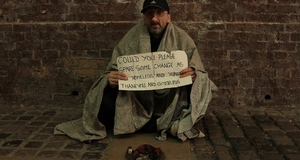Featured Article:Minorities and Homelessness in the United States and Europe: A Comparative AnalysisWithin the context that Caucasians are a minority in the shelter system, racial dynamics were at play there as well. Two Caucasians, not represented in table 8, seemed to display negative attitudes towards the others in the shelter as well as receive negative attitudes, something not heard in interviews with African Americans. For example, in brining up shelter life, one Caucasian woman referring to the others in the shelter said: “they’re the kind of people I would never associate with…they’re just rough..there’s very few Caucasians here..maybe they think I’m stuck up, there’s some that when I walk into a room they’ll walk out (interview with participant #14, July 11, 2012). One Caucasian male interviewed at a day program site stated that he sleeps on the street at night because he does not like the shelters: “it’s not the shelters it’s the people in the shelters” (interview with participant #13, June 28, 2012). As seen in table eight above, two immigrants alluded to discrimination or unfair treatment. Participant # 20 is a 45 years old Hispanic male who stated that he does not feel integrated in the United States because of the language barrier; he feels that his English is a handicap that holds him back in interactions with employers: “people notice that [the accent] and immediately I’m different” (interview with participant #20, June 18, 2012). He also stated that he believes he experienced a typical case of profiling in Florida, where police “harassed him” by following him and stopping him for no reason (interview with participant #20, June 18, 2012). The second immigrant believed he was erroneously denied social security benefits therefore discriminated against based on immigration status. Even though he is a legal resident with a green card, he stated that the Social Security Administration denied him benefits claiming he doesn’t have status (interview with participant #23, June 18, 2012). Therefore, direct discrimination was not a significant factor in the lives of a majority of Caucasians, and surprisingly, it was not a factor in the lives of most of the immigrants interviewed. African American experiences proved otherwise. A total of four African American women and seven African American men alluded to discriminatory or unfair treatment preceding homelessness. Their accounts bring forth noteworthy dynamics with regards to race relations. Four of the eleven African Americans had such negative experiences with other minority groups such as Hispanics and immigrants, rather than Caucasians. Participant #2 expressed that her lighter complexion resulted in undue attention from other African Americans in DC, who gave her a “you must think you’re better than” attitude (interview with participant #2, May 15, 2012). She also felt discriminated against by Hispanics in Texas, as that group was a majority where she resided (interview with participant #2, May 15, 2012).Participant #4, who was looking for employment at the time of the interview stated that when a friend referred her for a job, she was denied, being explicitly told that another undocumented person who was a family member of the employer would be hired because the undocumented person would work for a lower wage. The woman also stated that, having been in the employer’s seat in the past, she has had experience with “hiring your own and in turn not being hired [because of your race]” (interview with participant #4, May 22, 2012). In addition, the woman stated that once employers feel a person is homeless, there is a small likelihood that person would be hired (interview with participant #4, May 22, 2012). Participant #1 believed that discrimination by a Hispanic female manager led to him losing his job. Participant #1 was officially fired from a manual labor job in DC due to two no call no shows, even though he believes the first no show was not counted for others because there was a snow storm. He stated that the Hispanic manager treated African Americans different and more harshly, by making them have to “run and look for equipment whereas she gave others equipment and better duties or special treatment” (interview with participant #1, May 31, 2012). African American employees did eventually report these grievances to the human resources office, and the manager was put on probation. The man does not know the results of that process (interview with participant #1, May 31, 2012). Participant #9’s incident also occurred at his place of employment. Participant #9 did not specifically relate the details of the incident, but he expressed that he felt discriminated against by his Mexican restaurant manager, who was “trying to push his weight around” and who “fired me over something stupid” (interview with participant #9, June 13, 2012). He stated: “I think it was racially motivated” (interview with participant #9, June 13, 2012). Participant #9 took the case to an employment compliance department but was advised he did not have enough do prove discrimination (interview with participant #9, June 13, 2012). As seen in these experiences, racial dynamics are complex, and discrimination can originate from other groups rather than from the dominant group. Many of the phenomena Tilly discussed were evident in these participants’ lives. The stories allude to exploitation, such as when it was more beneficial to hire the undocumented worker. Opportunity hoarding is also evident, as the racial divisions between Hispanics and African Americans might originate from two minority groups attempting to compete against each other for scarce resources. These stories cannot be verified or legal determinations be made, but participants’ perceptions and feelings indicate that the dynamics involved in durable inequality have a role in minority homelessness, as these groups must face obstacles that are engrained in the fabric of society; many of the people mentioned lost employment and the fragile livelihood they were holding on to due to such incidents. Participant #7 is an African American woman who believes she was discriminated against when she lost her job. She was working as a dietary supervisor at a hospital and was fired for insubordination by her Caucasian manager, who had not given her any warnings in the past. Because of the insubordination, she was not able to receive unemployment benefits. She did not appeal the decision because she did not feel the appeals process worked in the favor of employees (interview with participant #7, June 4, 2012). Participant #9 also worked in a hospital. She believes she was unfairly treated and denied worker’s compensation when she injured her back on the job. She had to pay thousands of dollars in medical bills. Because she did not feel she was fairly compensated for her injury, she sewed the hospital but lost the case due to perceived bad representation. Participant #9 eventually lost her rental and ended up homeless (interview with participant #9, June 4, 2012). The majority of African American men felt they experienced discrimination in the criminal justice system and process in general. Participant #2 was in and out of jail for nine year on drug charges. He said he had many bad lawyers who did not put forth an effort to defend him, and would urge him to plead guilty even when “I felt the government didn’t have enough evidence to convict me” (interview with participant #2, May 23, 2012). He stated that the felony on his record truly interfered with employment; when he did get a job, he was shunned by colleagues who found out about his past and who “would all of a sudden stop talking to me once they heard” (interview with participant #2, May 23, 2012). Participant #3 was in and out of jail for eight years on drug charges such as crack and PCP. In one incident he was not carrying drugs and was approached at random: “there’s different kinds of sweeps, where four guys would just jump out on you; if something is found within 50 ft. it’s yours” (interview with participant #3, May 23, 2012). In another incident, which he did not serve time for, he was stopped by police on the street and arrested, mistaken for a fugitive from Texas, in a case of racial profiling; eventually the matter was cleared up (interview with participant #3, May 23, 2012). He is now fifty-one years old and has been homeless for nineteen years. He stated that he has had jobs while homeless, and was able to find part time jobs despite the criminal record but no full time jobs (interview with participant #3, May 23, 2012). Participant #4 spent months in and out of jail on drug charges. He feels police discriminated against him in 2011 when stopping him from walking on the sidewalk, for no perceived reason. When he asked why he is being stopped, police told him he was acting erratic and would be taken to the hospital to calm down. There, he was strapped to a bed and did not understand why police charged him with assaulting an officer. His lawyer convinced him to plead guilty and he received two years probation, though initially he stated: “I’m not pleading guilty for something I didn’t do” (interview with participant #4, June 4, 2012). Participant #6 was similarly convinced to plead guilty, although looking back he feels there wasn’t enough evidence against him when police arrested him for getting into a fight with someone accusing him of selling drugs. Participant #6 believes that a racially charged incident led him and his friend to act erratic and rob a bowling alley, after getting into an altercation with Caucasian employees and after being hit by one of them. He believes negative experiences from his childhood affected him, such as living in a Caucasian neighborhood and having a brick thrown through the window with the quote: “niggers are bad luck” (interview with participant #6, June 7, 2012). Participant #7 was involved in a similar incident involving a public place, in the 1970s; him and his friend were at the store in a predominantly Caucasian neighborhood when the store manager accused them of stealing, and wanted to check their bags. They resisted, and the police arrived, but by that time the store manager initiated a fight. Nothing was found in the briefcase and all charges were dropped. Participant #7 stated: I believe it was racial bias” (interview with participant #7, June 7, 2012). Therefore, African Americans interviewed experienced the most direct discrimination. Most of these experiences occurred at the place of employment. For the men, jail and the institutional racial bias were the most common factors. Women did not have this background. A total of nine out of ten African American men had been imprisoned, mostly on drug charges. This phenomenon confirms the life course hypothesis. While it is also true that the majority of the Caucasian men interviewed, five out of seven, also had a criminal background, only three of them had issues comparable to those of African Americans. Two of them did not have serious charges, for example participant #11 was arrested for a weekend because his sister, whom he was fighting a custody battle with, alleged he was violent (interview with participant #11, June 7, 2012). The second Caucasian man was arrested in 1970s for marijuana use, and stated that this was not put on his record and it did not interfere with employment; it was evident that his mental health contributed to his homelessness (interview with participant #12, June 18, 2012).Continued on Next Page » Suggested Reading from Inquiries Journal
Inquiries Journal provides undergraduate and graduate students around the world a platform for the wide dissemination of academic work over a range of core disciplines. Representing the work of students from hundreds of institutions around the globe, Inquiries Journal's large database of academic articles is completely free. Learn more | Blog | Submit Latest in Sociology |


















